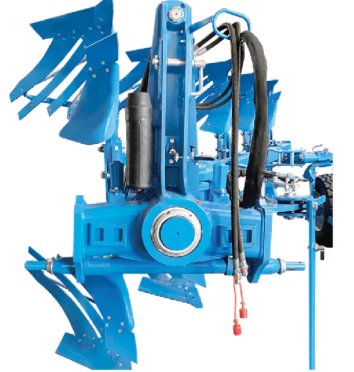Κατανόηση της επαναστατικής επίδρασης της άροσης στη γεωργική παραγωγικότητα
Σύγχρονη γεωργία βασίζεται σε μεγάλο βαθμό σε αποτελεσματικές τεχνικές διαχείρισης του εδάφους, με την άροση να βρίσκεται στην πρώτη γραμμή αυτών των πρακτικών. Η σχέση μεταξύ αερισμού του εδάφους με το αρότριο και της απόδοσης των καλλιεργειών αποτελεί ένα από τα πιο θεμελιώδη στοιχεία της επιτυχημένης καλλιέργειας. Όταν ένα αρότριο κόβει τη γη, ξεκινά μια σύνθετη σειρά διαδικασιών που μεταμορφώνουν το συμπιεσμένο έδαφος σε ένα θρεπτικό περιβάλλον για την ανάπτυξη των φυτών. Αυτή η γεωργική πρακτική, η οποία έχει εξελιχθεί κατά τη διάρκεια χιλιάδων ετών, συνεχίζει να διαδραματίζει σημαντικό ρόλο στα σύγχρονα συστήματα καλλιέργειας.
Η διαδικασία του αρόσεματος κάνει περισσότερα από το απλό αναποτισμό του εδάφους - δημιουργεί ένα περίπλοκο δίκτυο αερικών κυψελών που διευκολύνουν την ανάπτυξη των ριζών και την απορρόφηση θρεπτικών στοιχείων. Η μηχανική αυτή παρέμβαση βοηθά στη διάσπαση των συμπιεσμένων στρωμάτων του εδάφους, επιτρέποντας στις ρίζες να διεισδύουν βαθύτερα και να έχουν πρόσβαση σε νερό και ορυκτούς πόρους που προηγουμένως δεν ήταν διαθέσιμοι. Καθώς εξερευνούμε τα πολλαπλά οφέλη του αρόσεματος, θα ανακαλύψουμε πώς αυτή η αρχαία πρακτική παραμένει σχετική στη σύγχρονη γεωργία.

Η Επιστήμη Πίσω από την Αεριστική Επεξεργασία του Εδάφους Μέσω του Αρόσεματος
Φυσική Μεταμόρφωση της Δομής του Εδάφους
Όταν ένα αροτραίο μηχάνημα κινείται μέσα στο έδαφος, προκαλεί σαφείς αλλαγές στη φυσική σύσταση της γης. Η ενέργεια του μηχανήματος σπάει τα συμπιεσμένα σωματίδια του εδάφους, δημιουργώντας κενά μεταξύ των σωματιδίων του εδάφους που επιτρέπουν βελτιωμένη κυκλοφορία αέρα. Η διαδικασία αυτής της αναδιάρθρωσης είναι κρίσιμη για τη διατήρηση των ιδανικών συνθηκών του εδάφους, καθώς επιτρέπει την κατάλληλη ανταλλαγή αερίων μεταξύ του εδάφους και της ατμόσφαιρας.
Οι πρόσφατα δημιουργηθείσες αεριούχες κοιλότητες εξυπηρετούν πολλαπλούς σκοπούς στο οικοσύστημα του εδάφους. Παρέχουν απαραίτητες διαδρομές για την ανάπτυξη των ριζών, διευκολύνουν την κίνηση του νερού και δημιουργούν οικοτόπους για χρήσιμους μικροοργανισμούς του εδάφους. Η βελτιωμένη δομή του εδάφους συμβάλλει επίσης στην πρόληψη της υπερβολικής υγρασίας κατά τη διάρκεια έντονων βροχών, διατηρώντας παράλληλα επαρκή υγρασία κατά τις ξηρότερες περιόδους.
Ενισχυμένη Μικροβιακή Δραστηριότητα
Η εισαγωγή οξυγόνου μέσω της αερισμού του εδάφους κατά τον αρότραγο δρα ως καταλύτης για τη μικροβιακή δραστηριότητα στο έδαφος. Οι μικροσκοπικοί αυτοί οργανισμοί διαδραματίζουν σημαντικό ρόλο στη διάσπαση της οργανικής ύλης και στη μετατροπή της σε θρεπτικά συστατικά που τα φυτά μπορούν εύκολα να απορροφήσουν. Οι αυξημένες στάθμες οξυγόνου διεγείρουν τα αερόβια βακτήρια, τα οποία είναι ιδιαίτερα αποτελεσματικά στη διάσπαση οργανικών υλικών και στην απελευθέρωση απαραίτητων θρεπτικών στοιχείων.
Επιπλέον, η ενισχυμένη μικροβιακή δραστηριότητα συμβάλλει στη δημιουργία σταθερών συσσωματωμάτων του εδάφους, βελτιώνοντας τη δομή του με την πάροδο του χρόνου. Η βιολογική διαδικασία αυτή δημιουργεί έναν αυτοενισχυόμενο κύκλο, όπου η βελτίωση της αεριστικότητας οδηγεί σε αυξημένη μικροβιακή δραστηριότητα, η οποία με τη σειρά της προάγει καλύτερη δομή του εδάφους και συνεχή αεριστικότητα.
Επίδραση στην Ανάπτυξη της Ρίζας και την Απορρόφηση Θρεπτικών Στοιχείων
Διεύρυνση του Ριζικού Συστήματος
Η κατάλληλη αεριστικότητα του εδάφους μέσω της αρόσεως δημιουργεί ένα ιδανικό περιβάλλον για την ανάπτυξη των ριζών. Όταν το έδαφος είναι καλά αερισμένο, οι ρίζες μπορούν να αναπτυχθούν πιο εκτεταμένα και να διεισδύσουν βαθύτερα στο προφίλ του εδάφους. Το επεκταμένο ριζικό σύστημα επιτρέπει στα φυτά να έχουν πρόσβαση σε μεγαλύτερο όγκο εδάφους, αυξάνοντας τη δυνατότητά τους να απορροφούν νερό και θρεπτικά στοιχεία που είναι απαραίτητα για την ανάπτυξή τους.
Η μειωμένη αντίσταση του εδάφους σε καλά αεριζόμενο έδαφος επιτρέπει στις ρίζες να αναπτύσσουν πιο λεπτούς κλάδους και τριχίδια ριζών, τα οποία είναι κρίσιμα για την απορρόφηση θρεπτικών στοιχείων. Η βελτιωμένη αρχιτεκτονική των ριζών δεν βελτιώνει μόνο τη σταθερότητα των φυτών, αλλά αυξάνει και τη διαθέσιμη επιφάνεια για την απορρόφηση θρεπτικών στοιχείων, με αποτέλεσμα πιο δυνατά και υγιή φυτά.
Διαθεσιμότητα και Απορρόφηση Θρεπτικών Στοιχείων
Το καλά αεριζόμενο έδαφος προάγει καλύτερο κύκλο και διαθεσιμότητα θρεπτικών στοιχείων. Οι βελτιωμένες στάθμες οξυγόνου ενισχύουν τις χημικές και βιολογικές διεργασίες που μετατρέπουν τα θρεπτικά στοιχεία σε μορφές που μπορούν να χρησιμοποιηθούν από τα φυτά. Για παράδειγμα, οι διεργασίες δέσμευσης αζώτου και ορυκτοποίησης γίνονται πιο αποτελεσματικές σε καλά αεριζόμενες συνθήκες, καθιστώντας τα απαραίτητα θρεπτικά στοιχεία πιο προσβάσιμα στις καλλιέργειες.
Η μετακίνηση των θρεπτικών ουσιών μέσα από το προφίλ του εδάφους διευκολύνεται επίσης από την κατάλληλη αερισμό. Τα υδατοδιαλυτά θρεπτικά συστατικά μπορούν να κινηθούν πιο ελεύθερα μέσα από το εδαφικό διάλυμα, φτάνοντας πιο αποτελεσματικά στις ρίζες των φυτών. Η βελτιωμένη κινητικότητα των θρεπτικών ουσιών συμβάλλει σημαντικά στην ολική υγεία και παραγωγικότητα των καλλιεργειών.
Επιπτώσεις στη Διαχείριση του Νερού και την Υγεία του Εδάφους
Διήθηση και Διατήρηση Νερού
Η αρόση επηρεάζει σημαντικά τις δυνατότητες διαχείρισης νερού του εδάφους. Η βελτιωμένη δομή του εδάφους επιτρέπει στο νερό να διηθείται πιο αποτελεσματικά, μειώνοντας τους κινδύνους επιφανειακής απορροής και διάβρωσης. Οι δημιουργηθείσες κοιλότητες αέρα χρησιμεύουν ως προσωρινή αποθήκευση νερού, βοηθώντας στη διατήρηση της βέλτιστης υγρασίας για την ανάπτυξη των φυτών.
Η βελτιωμένη δομή του εδάφους επίσης προάγει την καλύτερη διανομή νερού σε όλη τη ζώνη των ριζών. Η βελτιωμένη κίνηση του νερού βοηθά στην πρόληψη της υπερβολικής υγρασίας σε περιόδους βροχής, ενώ εξασφαλίζει επαρκή διαθεσιμότητα υγρασίας κατά τη διάρκεια ξηρών περιόδων, δημιουργώντας ένα πιο σταθερό περιβάλλον ανάπτυξης για τις καλλιέργειες.
Μακροπρόθεσμα Οφέλη για την Υγεία του Εδάφους
Η κανονική αρότρωση, όταν γίνεται σωστά, συμβάλλει στη βελτίωση της μακροπρόθεσμης υγείας του εδάφους. Η πρακτική αυτή βοηθά στην ενσωμάτωση οργανικής ύλης σε βαθύτερα στρώματα του εδάφους, προάγοντας την αειφόρο κυκλοφορία των θρεπτικών στοιχείων και την ανάπτυξη της δομής του εδάφους. Η ενσωμάτωση των οργανικών υλικών βοηθά στη διατήρηση των επιπέδων άνθρακα στο έδαφος και υποστηρίζει ένα ποικίλο οικοσύστημα του εδάφους.
Οι συνολικές επιπτώσεις των σωστών πρακτικών αρότρωσης οδηγούν σε βελτιωμένη ανθεκτικότητα και γονιμότητα του εδάφους με την πάροδο του χρόνου. Ένα υγιές και καλά αεριζόμενο έδαφος είναι καλύτερα εξοπλισμένο να αντέχει στις περιβαλλοντικές πιέσεις και να διατηρεί την παραγωγική του ικανότητα καθ' όλη τη διάρκεια των καλλιεργητικών περιόδων.
Μεγιστοποίηση της Παραγωγής Καλλιεργειών Μέσω Βέλτιστων Πρακτικών Αρότρωσης
Εκτίμηση Χρονισμού και Συχνότητας
Η επιτυχία της αρότρωσης για την αεριστικότητα του εδάφους εξαρτάται σε μεγάλο βαθμό από τον σωστό χρονισμό και τη συχνότητα. Η αρότρωση θα πρέπει να πραγματοποιείται όταν οι συνθήκες υγρασίας του εδάφους είναι κατάλληλες - ούτε πολύ υγρές ούτε πολύ ξηρές. Αυτό εξασφαλίζει τη μέγιστη αποτελεσματικότητα, ενώ ελαχιστοποιείται η πιθανή ζημιά στη δομή του εδάφους.
Η συχνότητα του αρόσιμου πρέπει να είναι προσεκτικά εξισορροπημένη για να διατηρείται η βέλτιστη κατάσταση του εδάφους χωρίς να προκαλείται εξασθένιση. Οι σύγχρονες γεωργικές πρακτικές συχνά περιλαμβάνουν συστήματα μειωμένης εδαφοκάλυψης που συνδυάζουν τα οφέλη του αρόσιμου με τις αρχές διατήρησης του εδάφους.
Επιλογή και Λειτουργία Εξοπλισμού
Η επιλογή του κατάλληλου τύπου αροτρού και η σωστή του λειτουργία είναι αποφασιστικής σημασίας για την επίτευξη βέλτιστης αερισμού του εδάφους. Τα σύγχρονα αρότρα διατίθενται σε διάφορα σχεδιαστικά μοντέλα, τα οποία είναι κατάλληλα για συγκεκριμένους τύπους και συνθήκες εδάφους. Το βάθος και η ταχύτητα του αρόσιμου πρέπει να ρυθμίζονται σύμφωνα με τα χαρακτηριστικά του εδάφους και τις απαιτήσεις των καλλιεργειών.
Η σωστή συντήρηση και ρύθμιση του εξοπλισμού αρόσιμου εξασφαλίζει συνεχή ανατροπή και ανάμειξη του εδάφους, μεγιστοποιώντας τα οφέλη του αερισμού ενώ ελαχιστοποιείται ο κίνδυνος συμπύκνωσης του εδάφους. Τα προηγμένα σχέδια αροτρών περιλαμβάνουν χαρακτηριστικά που βοηθούν στη διατήρηση της βέλτιστης δομής του εδάφους, ενώ επιτυγχάνεται ο επιθυμητός αερισμός.
Συχνές Ερωτήσεις
Πόσο συχνά πρέπει να γίνεται άροση του εδάφους για βέλτιστο αερισμό;
Η συχνότητα του αρόσεματος εξαρτάται από διάφορους παράγοντες, όπως ο τύπος του εδάφους, το κλίμα και η περιστροφή των καλλιεργειών. Γενικά, το ετήσιο άροσμα είναι συνηθισμένο σε πολλά συστήματα καλλιέργειας, αλλά σε ορισμένα εδάφη μπορεί να είναι χρήσιμη η μείωση της συχνότητας. Είναι απαραίτητο να παρακολουθούνται οι συνθήκες του εδάφους και να προσαρμόζεται η συχνότητα του αρόσεματος βάσει των συγκεκριμένων απαιτήσεων του αγρού και των περιβαλλοντικών δεδομένων.
Ποια είναι τα σημάδια κακής αερισμού του εδάφους;
Ο κακός αερισμός του εδάφους εμφανίζεται συνήθως με τη μορφή εκφυλισμένης ανάπτυξης των φυτών, κίτρινων φύλλων, επιφανειακού ριζικού συστήματος και συγκέντρωσης νερού στην επιφάνεια. Το συμπιεσμένο έδαφος που είναι δύσκολο να διεισδύσει και έχει λίγους ορατούς πόρους ή ρωγμές είναι επίσης ενδεικτικό κακού αερισμού. Η τακτική αξιολόγηση του εδάφους μπορεί να βοηθήσει στην έγκαιρη διάγνωση αυτών των προβλημάτων.
Μπορεί το υπερβολικό άροσμα να προκαλέσει ζημιές στη δομή του εδάφους;
Ναι, η υπερβολική αρότρωση μπορεί να προκαλέσει πιθανή βλάβη στη δομή του εδάφους, καθώς διασπά υπερβολικά τα εδαφικά συσσωματώματα και δημιουργεί στρώματα συμπύκνωσης. Αυτό τονίζει τη σημασία της τήρησης κατάλληλων πρακτικών και χρονισμού αρότρωσης και, ενδεχομένως, της ενσωμάτωσης μεθόδων μειωμένης καλλιέργειας, όπου το επιβάλλεται, για τη διατήρηση της βέλτιστης υγείας του εδάφους.
Πίνακας Περιεχομένων
- Κατανόηση της επαναστατικής επίδρασης της άροσης στη γεωργική παραγωγικότητα
- Η Επιστήμη Πίσω από την Αεριστική Επεξεργασία του Εδάφους Μέσω του Αρόσεματος
- Επίδραση στην Ανάπτυξη της Ρίζας και την Απορρόφηση Θρεπτικών Στοιχείων
- Επιπτώσεις στη Διαχείριση του Νερού και την Υγεία του Εδάφους
- Μεγιστοποίηση της Παραγωγής Καλλιεργειών Μέσω Βέλτιστων Πρακτικών Αρότρωσης
- Συχνές Ερωτήσεις

